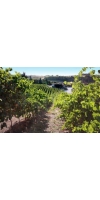Wine from Emilia-Romagna

A wine region located in Italy, Emilia-Romagna is quite possibly the most developed and richest wine region in Europe. The fertile soil is fertile spans nearly the entire width of peninsula in Northern Italy. The wine region of Emilia-Romagna is situated between Marche and Tuscany to the south, and Veneto, Lombardy and Piedmont to the north.
The history of the viticulture goes back to the seventh century BC, which makes it one of the oldest wine regions in Italy. Introduced by the Etruscans and adopted by the Romans the Vitis labrusca were used for centuries, with Vitis vinifera being the most predominately grown grape today. Emilia-Romagna is famous for Lambrusco.
The significant geography of Emilia-Romagna us what creates the different terroirs in the region. The western part of the region consists of Apennine peaks and hills that make their way to the lower-lying plains just east of Modena, Parma, and Bologna. Beyond that lay the coastal plains of the Ferrara province, with a notable portion of land hitting just below sea level. Flowing east to west, the Po River marks the northern part of the rebion bordering the Adriatic Sea.
The wine production of Emilia-Romagna's wine production is divided almost identically between whites and reds, with the dominant vine varieties being Lambrusco, Barbera, Malvasia, Bonardo and Sangiovese.
Lambrusco Amabile Bruscus San Valentino Red is 100% Lambrusco from grapes grown in the province of Modena and Reggio Emilia.
Traditional vinification methods combined with modern technology to produce wines of guaranteed quality. After the grapes are pressed, they are transferred to fermentation tanks where the must is racked off in an average of 70 hours. The wine then completes its first rapid fermentation process and passes to the slower fermentation phase, during which time it is racked off several times to improve its clarity. The wine is placed in an autoclave at strictly controlled temperatures wherein it undergoes a second fermentation. This is known as the Charmat Method. The temperature is controlled for full development of the bouquet and for the lively and natural sparkle so characteristic of this wine.
Deep ruby red with violet reflections and a fine perlage.
Intense vinous bouquet with hints of ripe red fruits.
Lively, fresh, sweet and inviting with bright fruit and a delightful sparkle.
Excellent by itself or with desserts of dark chocolate, gorgonzola, cheesecakes.
- back
Selected Options
Regions
Categories
Pricing
Countries
Regions
Grape Types
Wineries
Organic/Free Shipping
All older vintage wines have been purchased from a single collectors cellar. Pictures can be requested before shipment.
Ferren Chardonnay Sonoma Coast is made from 100 percent Chardonnay.
The Sonoma Coast bottling is a blend of barrels from Ferren's single vineyard offerings; Lancel Creek, Silver Eagle, Volpert, and Frei Road Vineyards. The wine is always somewhat more approachable early in its life as less new oak is used in the blend. Pure and translucent fruit is the hallmark of this cuvée. Citrus, quince, sea spray, and minerals are buoyed by refreshing acidity and a seamless finish.
Review:
A nuanced, tangy, mouthwatering and approachable wine that is both complex and very drinkable. The aromas are delicate, lifted and fresh, with oyster shells, lime zest, white flowers and chamomile. The palate is super fresh, layering salinity, richness and a long finish. Medium- to full-bodied. Drink or hold
-James Suckling 98 Points

-150x300.jpg)



